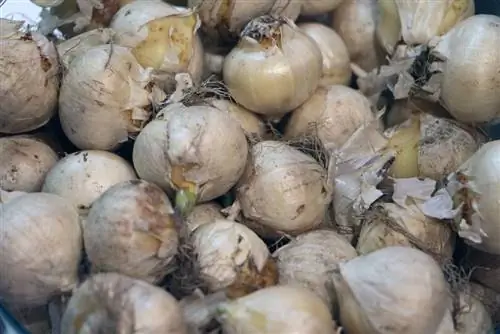- Author admin [email protected].
- Public 2023-12-17 03:39.
- Last modified 2025-01-24 12:45.
A flower bulb has grown for every design idea in the bed, on the balcony and in living rooms. Of course, not all onion flowers are frost-resistant and have to overwinter appropriately. This guide will familiarize you with when to dig up flower bulbs professionally, store them correctly and guide them through the winter in an exemplary manner. Here you can read tried and tested information for 15 types of flower bulbs from A, like cyclamen, to Z, like ornamental garlic.
From A to D
Cyclamen (Cyclamen)
A colorful dance of cyclamen species for spring, summer and autumn brings cheerful splashes of color to the flowerbed and to the balcony. The robust European species have a reliable frost hardiness of up to -23 degrees Celsius, which improves from year to year.
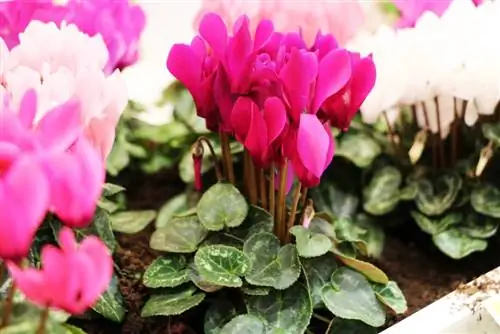
How to overwinter cyclamen in beds and pots:
- Deciduous species cut back after harvesting to just a few centimeters above the tuber
- In the year of planting and the following two years, cover the soil in the bed and pot with leaves, bark mulch or fleece
- Additionally cover pots or boxes with foil or jute
- Alternatively, place plant containers in a bright, frost-free location behind glass
Please note that evergreen and wintergreen species continually evaporate water. Therefore, water your cyclamen in winter as soon as the soil dries.
Tip:
Cyclamens for indoor cultivation bloom from September to March. The tubers stop growing in the summer. For this reason, overwintering becomes oversummering. In a shady, cool place in the garden, only water the tubers in the pot little by little. At the same time as budding begins in early autumn, pot the oversummer cyclamen into fresh substrate and begin the normal care program on the partially shaded windowsill.
Bluestar (Scilla)
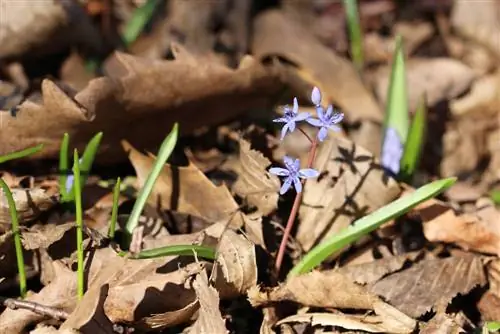
The small flower bulbs, measuring a maximum of 1 cm in size, do not show that they can survive temperatures down to -23.4 degrees Celsius without damage. In fact, squills grow wild quickly even in heavy garden soil and form picturesque carpets of flowers. On the way there, the young tubers are grateful for some light winter protection. In the year of planting, simply cover the bed area with autumn leaves and pine fronds.
Buntwurz, Buntblatt (Caladium)
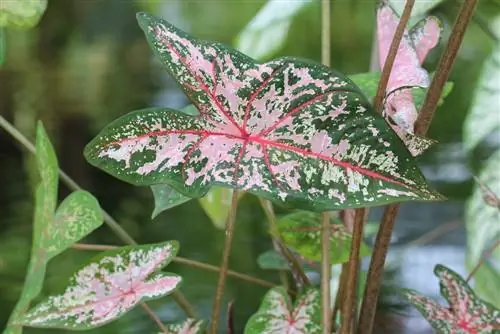
The popular houseplant sprouts its attractive leaves from a fleshy tuber. In autumn, Buntwurz pulls in its colorful foliage and falls into a dormant period of growth. Indoor gardeners mistakenly misinterpret this process and throw away the exotic plant. In fact, the impressive elephant ear is well suited for cultivation over several years. How to overwinter the dormant tubers:
- Stuffing the fleshy onion
- Cut off dead leaves
- Dig in a box with dry peat or sand
- Store in a cool, dark cellar
In spring, pot caladium tubers in potting soil and grow them in a bright window seat at 21 degrees Celsius.
Dahlia (Dahlia)
The procedure for overwintering dahlias is exemplary for a variety of non-hardy flower bulbs and tubers. Our instructions are dedicated to the proven method in detail and refer to other suitable methods in this guide. This is how you proceed in an exemplary manner step by step:
- Do not fertilize from the beginning of September
- From mid-October, gradually water less, but do not let the soil dry out
- After the first frost, cut off all stems except for 10 centimeters above the tuber
- Use a digging fork to loosen the soil and lift out dahlia tubers
- Shake off or brush off soil
- Sort out the intact tubers and let them dry upside down for a few days
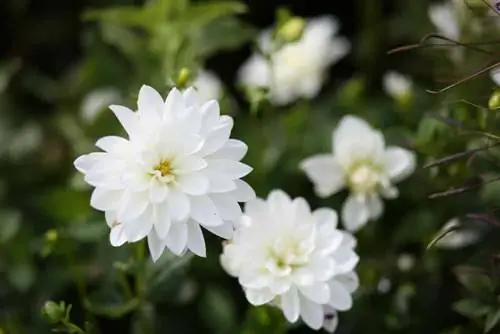
Dahlia tubers only form their buds for the next season when they have experienced a cold stimulus with temperatures close to freezing point. Therefore, wait for the first nightly frost before digging up the rhizomes and hibernating them. After the tubers have dried, cut the roots down to a few centimeters and dust the cuts with rock dust or charcoal ash. The 10 centimeter long stem remains on the rootstock. Now fill wooden boxes with sand or peat. Bury the dahlia tubers next to each other without touching them. The plants overwinter in a dark, airy location at a cool 5 degrees Celsius. Basements, the attic or a windowless, frost-free garage are well suited as winter quarters.
Dahlia tubers should be checked at regular intervals. Specimens with rotting spots or pest infestation are sorted out. It is an advantage if you rotate the flower bulbs at this time. Although dry conditions are important for the overwintering process, the tubers must not dry out completely. If the epidermis is in danger of withering, please spray dahlias with lime-free water.
From G to K
Gladiolus (Gladiolus)
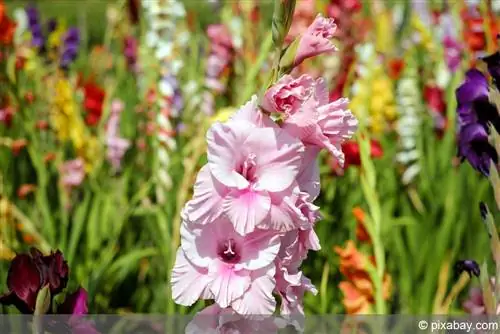
With their majestic flower candles, gladioli attract everyone's attention from summer until the first frost. The magnificent iris plants are happy to repeat the flower show over several years, as long as they are granted a protected winter. Thanks to its subtropical origin, temperatures below freezing mean the inevitable end for a gladiolus. You can effectively prevent this dilemma with the following approach:
- After the first frost, cut off the retracted plant parts
- Dig up the tubers and knock off any remaining soil
- Cut off daughter bulbs and long roots with a sharp, disinfected knife
Place the cleaned gladiolus tubers with the roots facing upwards in a box with slightly damp sand. Alternatively, wrap the rhizomes in peat moss or newspaper. Dark, cool and airy at a maximum of 15 degrees Celsius, the tubers overwinter until early spring. Please do not throw away the daughter bulbs. Ideally, you should use the quiet winter time to plant the nodules in seed soil so that they bloom after 3 years at the latest.
Golden Alstroem Lily (Alstroemeria aurea)
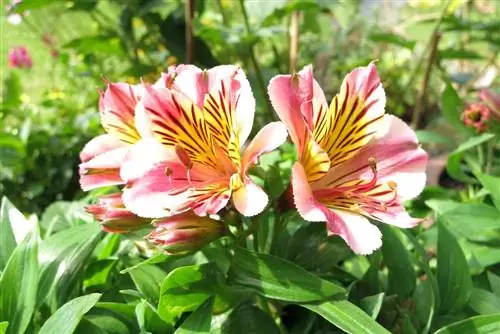
In 1833, a magnificent onion flower found its way into our gardens from Chile, which has lost none of its exotic magic to this day. The golden-yellow-orange calyxes shine from June until the first frost. The underground tuber is only partially hardy and requires protective measures. Cut off the drawn-in plant residues. Then cover the root disc with leaves and pine branches. Where the thermometer falls below - 15 degrees Celsius in winter, we recommend overwintering using the dahlia method described in detail above.
Lucky Clover (Oxalis tetraphylla formerly Oxalis deppei)
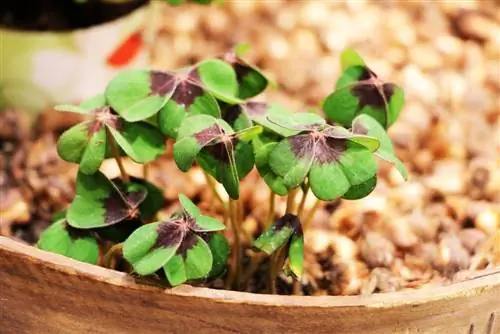
If you want to give a little boost to luck in the bed and on the balcony, four-leaf lucky clover bulbs are an excellent choice. The magical leaves sprout from bulblets that are 1.5 to 3.5 centimeters long. White or pink flowers bloom from June to October. The sorrel plant is not hardy, so it is preferably cultivated in pots or balcony boxes. This is how you properly overwinter the flower bulbs:
- Put away in autumn when temperatures fall below 10 degrees Celsius
- Cut off wilted flowers and leaves
- Set up in a bright location at an ideal 15 degrees Celsius
- Watering more economically
- Do not fertilize between October and March
In April, wake up lucky clover from hibernation by repotting the flower bulbs in fresh substrate and resuming the normal care program.
Indian flower cane (Canna indica)
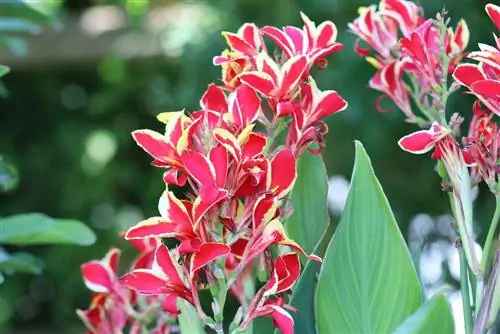
Indian flower cane has captivated home gardeners for more than 200 years when it spreads a South Sea feeling with its summer flowers in the garden. Majestic stems with opulent flowers rise from tubers up to 60 cm in size and appear from June to October. This much exotic splendor is no match for a Central European winter. A single frosty autumn night is enough for the herbaceous parts of the plant to retreat. Cut the Indian flower tube back to 15 centimeters in order to overwinter the tubers in a dry and cool place using the dahlia method.
Kalla (Zantedeschia)
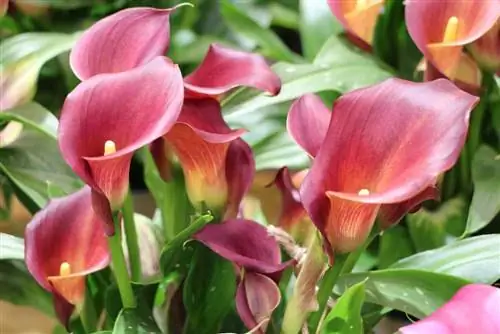
Bulb-forming calla lilies add an elegant touch to the summer garden with white or colored funnel flowers. Zantedeschia with a flowering period from June to August are native to South Africa and are extremely sensitive to cold. Before the onset of winter, cut back the dead plant parts to 8 centimeters. Then dig up the calla tubers and remove the remaining soil. After they have air-dried for a few days, winterize the flower bulbs. A dark, airy room with temperatures that do not rise above 15 degrees Celsius is ideal as a storage location. Please check your floral winter guests regularly. If the tubers shrivel due to excessive dryness, spray them with a little room temperature water.
From M to Z
Montbretie (Crocosmia)
Montbretia cannot deny their close relationship with gladioli. Both flower beauties come from subtropical regions and sprout strong flower bulbs. The majority of Montbretien varieties are somewhat more sensitive to cold than gladioli. We recommend picking up the rhizomes before the first frost and storing them in dry peat soil in the dark winter quarters. You can either plant the overwintered tubers in March or plant them in the bed in mid-May.
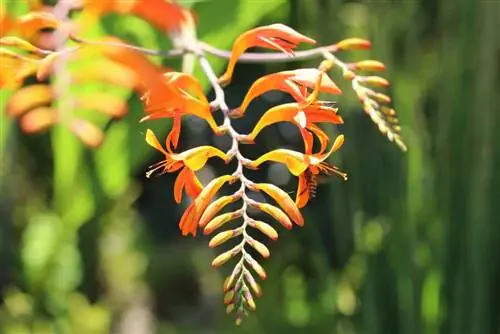
Tip:
Numerous flower bulbs and tubers look very similar in their winter quarters. Label each plant so you can assign each species to its correct location at the beginning of planting time.
Belt leaf (Clivia)
The evergreen houseplants have an unspectacular appearance in summer and autumn. That changes suddenly when huge, brightly colored flower umbels unfold from February to May. Beforehand, Clivia tubers go through a winter rest period of several months in order to gain strength for the furious flower show. How to overwinter a strap leaf with gardening expertise:
- In autumn, change location to a bright, unheated room
- Ideally set up at temperatures of 5 to 10 degrees Celsius
- Water little by little and do not fertilize
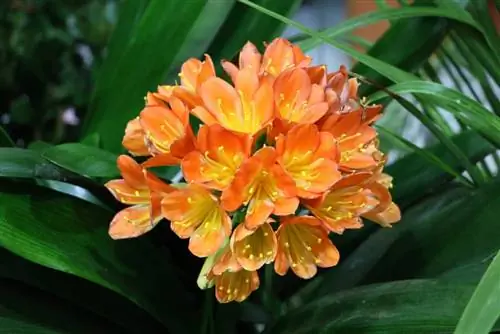
Check your belt blade regularly in winter quarters. If the emergence of flower stalks signals the beginning of the flowering period, the houseplant returns to its usual bright location in the living room. Increase the watering and add a little liquid fertilizer to the irrigation water.
Knight's Star (Amaryllis)
With flowers up to 20 centimeters large, a knight's star competes with the Christmas tree. We owe the winter flower magic to voluminous, spherical flower bulbs. Since amaryllis are native to South America, they lack any winter hardiness. Due to the winter flowering period, a special care program must be observed so that the exotic plant decides to sprout flower stems and buds. How to do it right:
- Water gradually less from July until the substrate has dried out at the end of August
- Stop adding fertilizer at the beginning of August
- Store in dry soil from September to November in darkness and 5 to 9 degrees Celsius
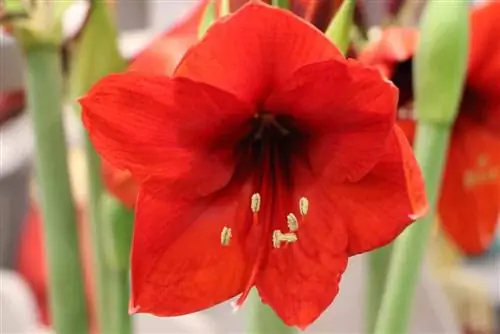
6 to 8 weeks before the desired flowering period begins, pot the flower bulb in fresh substrate. Then move the amaryllis to a bright, not full-sun window spot with temperatures of 18 to 22 degrees Celsius. Parallel to the progress of growth, increase the water and nutrient supply.
Chocolate Flower (Cosmos atrosanguineus)
The exotic rarity comes from the sun-drenched regions of Mexico and delights with seductively scented flowers from July to October. Consequently, a chocolate flower can only be certified as having limited winter hardiness with a minimum temperature of -6 degrees Celsius. Before the first frost, cut all the stems to a hand's width above the ground and dig up the tubers.
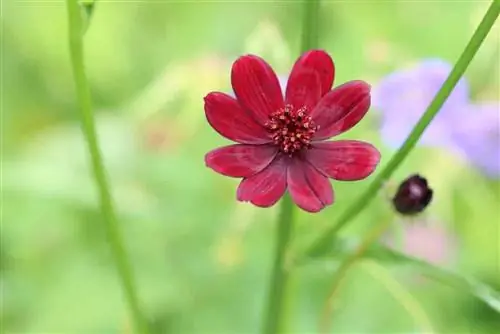
Your chocolate flowers, including the remains of their stems, will overwinter in a box with dry peat or sand at a cool 5 degrees Celsius. From mid-March, the winter dormancy ends by planting the tubers in pots with fresh potting soil. The normal care program gradually begins on the sunny, warm windowsill.
Steppencandle (Eremurus)
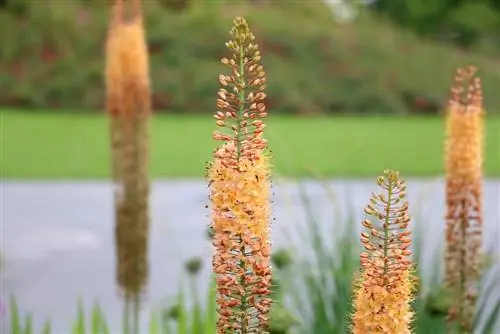
Steppe candles have a frost hardiness of up to -23.4 degrees Celsius. The flower bulbs have to develop this robust winter hardiness over the course of the first two years of growth. Please protect the freshly planted bulbs with a layer of compost, bark mulch or autumn leaves. Since the buds are just below the surface of the earth in spring, they are at risk from late frost. Covering with garden fleece from March to mid-May reliably prevents frost damage.
Ornamental onion, flower onion (Allium)
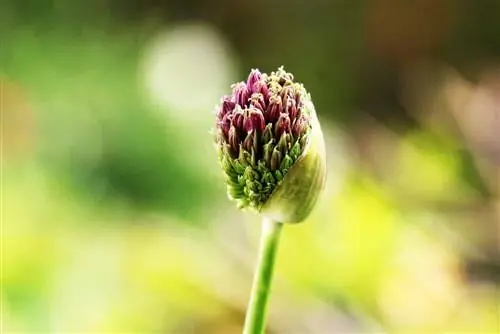
In rock gardens and flower borders, ornamental onions live up to their name. Home gardeners are spoiled for choice among multi-faceted varieties, such as globe ornamental onion with flowers up to 20 centimeters in size in May and June. What all species and varieties have in common is that they are frost-resistant in regions up to winter hardiness zone 6 (-17.8 to -23.3 degrees Celsius). During the planting year and in rough locations, we recommend overwintering the flower bulbs under a protective layer of compost or leaves.



